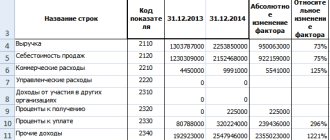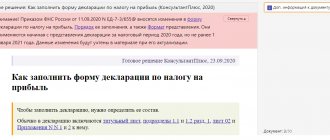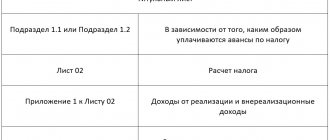Posting contents debit 99 credit 99
Posting Dt 99 Kt 99 is formed once at the end of the year when summing up the results and is part of the balance sheet reformation.
In fact, this is an operation consisting of several entries Dt 99 Kt 99 inside account 99 “Profit and Loss”, depending on the number of subaccounts. The operation in practice is called “Closing accounts”. It consists of assigning the values accumulated in subaccounts to one subaccount, which reveals the final annual financial result.
To understand how this happens, you need to familiarize yourself with the internal structure of account 99 and consider how subaccounts are opened for it.
How the 99 count works and its analytics
The count of 99 is used to summarize results. The resulting performance indicators are included in the financial statements. Accordingly, the analytics device must meet the main goal - the preparation of reliable reporting.
IMPORTANT! The instructions for the Chart of Accounts contain a direct indication of the need to build analytical accounting on account 99 to structure the data included in the financial results report.
Starting from the first month of the year, account 99 serves to accumulate information about the results of the organization’s work. The account accumulates:
- result from sales within the main activity;
- the result of other operations;
- amounts of recalculation of income tax and sanctions.
The account also keeps records of the values defined by PBU 18/02 (if the organization is obliged/decided to apply it):
- conditional expense/income (UR/UD);
- permanent tax liabilities and assets (PNO, PNA);
- write-off deferred tax liabilities and assets (ONO, ONA).
When opening sub-accounts, it is advisable to take into account how information should be grouped and reflected in the statement of financial results (Form 2). At the same time, it is important to follow the legal requirements for recording this information. It is optimal to use the following subaccounts:
- 99.1 “Profit and loss”:
- 99.1.1 “Profit (loss) before tax.” To take into account the indicators that form the reporting item of the same name, the result of sales for core activities and other operations.
- 99.1.2 “Other profits and losses.” To account for the amounts of recalculation of income tax, tax sanctions, written off by ONO and ONA, grouped in the item “Other”.
Maximum information content is achieved by maintaining analytics on sub-accounts in the context of the component indicators taken into account. Modern software products allow you to conduct analytics within a subaccount without unnecessarily cluttering up accounting.
- 99.2 “Calculation of income tax.” To account for amounts involved in the disclosure of information on income tax calculations in accordance with PBU 18/02.
- 99.2.1 “Conditional consumption”.
- 99.2.2 “Conditional income”.
- 99.2.3 “PNO (PNA)”.
Account 99 in accounting
The name of the account clearly indicates its purpose: the account is used to accumulate and reflect the final financial result. Profits and income are reflected on the credit of the account, losses and expenses are reflected on the debit.
In general, the structure of account 99 can be represented by the following diagram:
Throughout the year the account reflects:
- profits (losses) from ordinary activities - in correspondence with account 90;
- profits (losses) from other activities - in correspondence with 91 accounts;
- the amount of accrued conditional income (expense) for income tax;
- amounts of permanent obligations and accrued payments, penalties, penalties, etc.
The account movements can be shown schematically as follows:
Extraordinary income (expenses) are the receipts (expenses) of funds associated with unplanned events. For example, receipts of insurance compensation, losses due to natural disasters and emergency incidents, etc.
At the end of the reporting year, account 99 is closed to account 84 “Retained earnings (loss)”, and there is no balance left on it. Profit will be reflected by posting Dt 99 - Kt 84, loss Dt 84 - Kt 99.
Account 99 corresponds with the accounts:
Posting Dt 99 - Kt 09 means the disposal of the ONA object accounted for Dt 09.
Subaccounts 99 accounts
Analytics of account 99 should be built taking into account the possibility of generating a Report on the financial results of the enterprise. For these purposes, it is recommended to create main subaccounts for the account:
At the discretion of the organization, the numbers and purpose of subaccounts may change. Also, to reflect information in more detail, organizations can create 3rd or 4th level subaccounts for these subaccounts.
According to the current Chart of Accounts, income tax (IP) is charged to account 99 in correspondence with account 68, a subaccount for settlements under IP. For this purpose, separate sub-accounts are created on account 99, most often 99.2 “Income Tax”, which can be divided into sub-accounts to reflect conditional income and conditional expenses for NP.
The amount of tax accrued to the budget is reflected by posting Dt 99 - Kt 68.
Posting of the type Dt 68 - Kt 99 “Conditional income under NP” reflects the loss received in accounting.
Closing 99 accounts
There are several ways to close a 99 account. But the method using subaccount 99.9 can be considered methodologically correct. In this case, the total for all subaccounts 99 is collected in this account, that is, the subaccount can be called regulating.
During the year, when the account is closed monthly, the balance Dt means a loss, the balance Kt means profit. Consequently, when closing the year in correspondence with account 84, the debit balance will mean a profit, and the credit balance will mean a loss.
Movement on account 99 and compliance of its data with reporting indicators
Having examined the internal structure of the account, it’s time to start studying the movement on the account. Let's look at a conditional example of what happens inside the account, how the results are reflected by postings Dt 99 Kt 99 , how its data is compared with reporting data.
Example:
The final indicators of the organization for the year are given, presented in the table in order of the articles of Form 2.
| Index | Reporting line code | Amount, rub. | Note |
| Net revenue | 2110 | 10 000 000 | |
| Cost price | 2120 | (9 000 000) | |
| Profit (loss) from sales | 2200 | 1 000 000 | |
| Other income | 2340 | 500 000 | |
| other expenses | 2350 | (440 000) | |
| including other social expenses | (40 000) | The organization did not take into account the amount as expenses to determine taxable profit | |
| Profit (loss) before tax | 2300 | 1 060 000 | |
| Current income tax | 2410 | (220 000) | The value is equal to the tax payable on the tax return: 10 000 000 – 9 000 000 + 500 000 – (440 000 – 40 000) = 1 100 000; 1 100 000 × 20% = 220 000 |
| including PNO (PNA) | 2421 | 8 000 | 40 000 × 20% = 8 000 PNO by amount of social expenditures |
| Other | 2460 | (1 000) | tax penalties |
| Net income (loss) | 2400 | 839 000 | |
| Conditional consumption | (212 000) | 1 060 000 × 20% = 212 000 |
See also the article “Filling out Form 2 of the balance sheet (sample)” .
The table below contains entries using recommended subaccounts and example data.
| Wiring | Sum | Decoding |
| Wiring Dt 90, 91 Kt 99 | ||
| Dt 90.9 Kt 99.1.1 | 1 000 000 | This is how the monthly sales total is summed up, which is added up on account 99.1.1: (10,000,000 – 9,000,000). Note. The example shows a positive result. If a loss is received during the month, then the posting Dt 99 Kt 90 is used. |
| Dt 91.9 Kt 99.1.1 | 60 000 | This is how the monthly total for other transactions is summed up, which is added up on account 99.1.1: (500,000 – 440,000). Note. The example shows a positive result. If a loss is received during the month, then the posting debit 99 credit 91 is applied. |
| Wiring Dt 99 Kt 68 | ||
| Dt 99.1.2 Kt 68 / calculations with the budget | 1 000 | The amount of penalties determined by the tax inspectorate is reflected |
| Dt 99.2.3 Kt 68 / calculation of income tax | 8 000 | Reflected PNO |
| Dt 99.2.1 Kt 68 / calculation of income tax | 212 000 | Conditional consumption generated |
For information on how to record income tax on account 68, read the article “Which accounts are used to record the amount of income tax? ”
When closing subaccounts, it is necessary to generate transactions in the format in question Dt 99 Kt 99:
| Wiring | Sum |
| Dt 99.1.1 Kt 99.9 | 1 060 000 |
| Dt 99.9 Kt 99.1.2 | 1 000 |
| Dt 99.9 Kt 99.2.1 | 212 000 |
| Dt 99.9 Kt 99.2.3 | 8 000 |
The turnover and accumulated balance of account 99 before the reformation and after the closure of sub-accounts, as well as the comparability of account data with the lines of Form 2 are shown in the table:
| Subaccount | Debit turnover | Loan turnover | Debit balance | Credit balance | Reporting line code |
| Before the Reformation | |||||
| 99.1.1 | 1 060 000 | 1 060 000 | 2 300 | ||
| 99.1.2 | 1 000 | 1 000 | 2 460 | ||
| 99.2.1 | 212 000 | 212 000 | conditional flow | ||
| 99.2.3 | 8 000 | 8 000 | 2 421 | ||
| After closing | |||||
| 99.1.1 | 1 060 000 | 1 060 000 | |||
| 99.1.2 | 1 000 | 1 000 | |||
| 99.2.1 | 212 000 | 212 000 | |||
| 99.2.3 | 8 000 | 8 000 | |||
| 99.9 | 221 000 (1 000 + 212 000 + 8 000) | 1 060 000 | 839 000 (1 060 000 – 221 000) | 2 400 | |
As a result of the operation from a series of entries in the format Dt 99 Kt 99, a credit balance was formed in subaccount 99.9 equal to the net profit for the year in the amount of RUB 839,000. The amount must correspond to line 2400 of Form 2.
Closing account 99
At the end of the year, account 99 is reset to zero with the difference assigned to account 84 “Retained earnings (uncovered loss)”: the so-called “balance sheet reformation” occurs. At the end of the year, the posting of Debit 99 – Credit 84 means that the identified final profit at the end of the year for all types of activities is included in the profits (losses) of previous years. And the loss at the end of the year is reflected: Debit 84 – Credit 99.
Thus, the answer to the question “Profit on the debit or credit of account 99” is as follows: during the year, the balance on account 99 in credit means a profit, and on the debit - a loss. Accordingly, debiting account 99 during the year means recognizing a monthly loss (as well as charging income tax and sanctions), and crediting means profit. Consequently, crediting account 99 at the end of the year when reforming the balance sheet means that the year ended with a loss, and debiting (Debit account 99 - Credit account 84) means that at the end of the year a profit was made.
The main goal of every organization is to make a profit. In this case, it is necessary to take into account each completed business transaction, since it directly affects the formation of the final result of the activity. The amount of profit generated (or loss incurred) can be found out only with the complete and systematic accumulation of relevant information on a special balance sheet account 99.
Debit 99 credit 09
This is a posting for writing off the amount of ONA. PBU 18/02 describes 2 cases of write-off of IT:
- If the tax rate changes, then the accumulated IT is changed by recalculating the balance of deductible temporary differences (DTT) at the new rate. The difference between the accumulated and recalculated amounts is posted to account 99, as required by the regulations.
- If the asset that determined the accrual of the tax is disposed of, then the tax is subject to write-off to the extent that the profit for taxation will not be reduced in accordance with the legislation of the Russian Federation.
If the accounting of VVR and ONA is carried out correctly, then IT, as a rule, is completely repaid with a decrease in VVR. If accounting errors have been identified, then when they are corrected, it may be necessary to write off IT as a loss.
Cases of write-off of IT of the same kind are reflected in the same way in accounting: Dt 77 Kt 99.
Postings dt 99 and kt 99, 68, 84, 91, 09 (nuances)
Dt 99 Kt 99 - this posting is an important component of the balance sheet reform when summing up the organization’s activities for the year. What are the legal requirements for accounting for profits and losses, what amounts can be attributed to the debit of account 99 and the credit of accounts 68, 84, 91, 09, what nuances characterize these postings - we will talk about all this in our article.
postings debit 99 credit 99
How the 99 count works and its analytics
Movement on account 99 and compliance of its data with reporting indicators
Debit 99 credit 84
Debit 99 credit 09
Results
postings debit 99 credit 99
Posting Dt 99 Kt 99 is formed once at the end of the year when summing up the results and is part of the balance sheet reformation.
In fact, this is an operation consisting of several entries Dt 99 Kt 99 inside account 99 “Profit and Loss”, depending on the number of subaccounts. The operation in practice is called “Closing accounts”. It consists of assigning the values accumulated in subaccounts to one subaccount, which reveals the final annual financial result.
To understand how this happens, you need to familiarize yourself with the internal structure of account 99 and consider how subaccounts are opened for it.
How the 99 count works and its analytics
The count of 99 is used to summarize results. The resulting performance indicators are included in the financial statements. Accordingly, the analytics device must meet the main goal - the preparation of reliable reporting.
IMPORTANT! The instructions for the Chart of Accounts contain a direct indication of the need to build analytical accounting on account 99 to structure the data included in the financial results report.
Starting from the first month of the year, account 99 serves to accumulate information about the results of the organization’s work. The account accumulates:
- result from sales within the main activity;
- the result of other operations;
- amounts of recalculation of income tax and sanctions.
The account also keeps records of the values defined by PBU 18/02 (if the organization is obliged/decided to apply it):
- conditional expense/income (UR/UD);
- permanent tax liabilities and assets (PNO, PNA);
- write-off deferred tax liabilities and assets (ONO, ONA).
When opening sub-accounts, it is advisable to take into account how information should be grouped and reflected in the statement of financial results (Form 2). At the same time, it is important to follow the legal requirements for recording this information. It is optimal to use the following subaccounts:
- 99.1 “Profit and loss”:
- 99.1.1 “Profit (loss) before tax.” To take into account the indicators that form the reporting item of the same name, the result of sales for core activities and other operations.
- 99.1.2 “Other profits and losses.” To account for the amounts of recalculation of income tax, tax sanctions, written off by ONO and ONA, grouped in the item “Other”.
Maximum information content is achieved by maintaining analytics on sub-accounts in the context of the component indicators taken into account. Modern software products allow you to conduct analytics within a subaccount without unnecessarily cluttering up accounting.
- 99.2 “Calculation of income tax.” To account for amounts involved in the disclosure of information on income tax calculations in accordance with PBU 18/02.
- 99.2.1 “Conditional consumption”.
- 99.2.2 “Conditional income”.
- 99.2.3 “PNO (PNA)”.
Movement on account 99 and compliance of its data with reporting indicators
Having examined the internal structure of the account, it’s time to start studying the movement on the account. Let's look at a conditional example of what happens inside the account, how the results are reflected by postings Dt 99 Kt 99 , how its data is compared with reporting data.
Example:
The final indicators of the organization for the year are given, presented in the table in order of the articles of Form 2.
| Index | Reporting line code | Amount, rub. | Note |
| Net revenue | 2110 | 10 000 000 | |
| Cost price | 2120 | (9 000 000) | |
| Profit (loss) from sales | 2200 | 1 000 000 | |
| Other income | 2340 | 500 000 | |
| other expenses | 2350 | (440 000) | |
| including other social expenses | (40 000) | The organization did not take into account the amount as expenses to determine taxable profit | |
| Profit (loss) before tax | 2300 | 1 060 000 | |
| Current income tax | 2410 | (220 000) | The value is equal to the tax payable on the tax return: 10,000,000 – 9,000,000 + 500,000 – (440,000 – 40,000) = 1,100,000; 1,100,000 × 20% = 220,000 |
| including PNO (PNA) | 2421 | 8 000 | 40,000 × 20% = 8,000 PNO for the amount of social expenses |
| Other | 2460 | (1 000) | tax penalties |
| Net income (loss) | 2400 | 839 000 | |
| Conditional consumption | (212 000) | 1 060 000 × 20% = 212 000 |
See also the article “Filling out Form 2 of the balance sheet (sample)” .
The table below contains entries using recommended subaccounts and example data.
| Wiring | Sum | Decoding |
| Wiring Dt 90, 91 Kt 99 | ||
| Dt 90.9 Kt 99.1.1 | 1 000 000 | This is how the monthly sales total is summed up on account 99.1.1: (10,000,000 – 9,000,000). Note. The example shows a positive result. If a loss is received during the month, then the posting Dt 99 Kt 90 is used. |
| Dt 91.9 Kt 99.1.1 | 60 000 | This is how the monthly total for other transactions is summed up, which is added up on account 99.1.1: (500,000 - 440,000). Note. The example shows a positive result. If a loss is received during the month, then the posting debit 99 credit 91 is applied. |
| Wiring Dt 99 Kt 68 | ||
| Dt 99.1.2 Kt 68 / calculations with the budget | 1 000 | The amount of penalties determined by the tax inspectorate is reflected |
| Dt 99.2.3 Kt 68 / calculation of income tax | 8 000 | Reflected PNO |
| Dt 99.2.1 Kt 68 / calculation of income tax | 212 000 | Conditional consumption generated |
For information on how to record income tax on account 68, read the article “Which accounts are used to record the amount of income tax? ”
When closing subaccounts, it is necessary to generate transactions in the format in question Dt 99 Kt 99:
| Wiring | Sum |
| Dt 99.1.1 Kt 99.9 | 1 060 000 |
| Dt 99.9 Kt 99.1.2 | 1 000 |
| Dt 99.9 Kt 99.2.1 | 212 000 |
| Dt 99.9 Kt 99.2.3 | 8 000 |
The turnover and accumulated balance of account 99 before the reformation and after the closure of sub-accounts, as well as the comparability of account data with the lines of Form 2 are shown in the table:
| Subaccount | Debit turnover | Loan turnover | Debit balance | Credit balance | Reporting line code |
| Before the Reformation | |||||
| 99.1.1 | 1 060 000 | 1 060 000 | 2 300 | ||
| 99.1.2 | 1 000 | 1 000 | 2 460 | ||
| 99.2.1 | 212 000 | 212 000 | conditional flow | ||
| 99.2.3 | 8 000 | 8 000 | 2 421 | ||
| After closing | |||||
| 99.1.1 | 1 060 000 | 1 060 000 | |||
| 99.1.2 | 1 000 | 1 000 | |||
| 99.2.1 | 212 000 | 212 000 | |||
| 99.2.3 | 8 000 | 8 000 | |||
| 99.9 | 221 000(1 000 + 212 000 + 8 000) | 1 060 000 | 839 000(1 060 000 – 221 000) | 2 400 |
As a result of the operation from a series of entries in the format Dt 99 Kt 99, a credit balance was formed in subaccount 99.9 equal to the net profit for the year in the amount of RUB 839,000. The amount must correspond to line 2400 of Form 2.
Debit 99 credit 84
This is the last posting of the year in the chain of postings of the reformation procedure. It contains good news: the organization earned a profit for the year. For the example given, an entry is drawn up reflecting retained earnings: Dt 99.9 Kt 84 - RUB 839,000.
If the organization operates at a loss, then account 99.9 has a debit balance equal to the uncovered loss. It is posted to the debit of account 84: Dt 84 Kt 99.9.
Debit 99 credit 09
This is a posting for writing off the amount of ONA. PBU 18/02 describes 2 cases of write-off of IT:
- If the tax rate changes, then the accumulated IT is changed by recalculating the balance of deductible temporary differences (DTT) at the new rate. The difference between the accumulated and recalculated amounts is posted to account 99, as required by the regulations.
- If the asset that determined the accrual of the tax is disposed of, then the tax is subject to write-off to the extent that the profit for taxation will not be reduced in accordance with the legislation of the Russian Federation.
If the accounting of VVR and ONA is carried out correctly, then IT, as a rule, is completely repaid with a decrease in VVR. If accounting errors have been identified, then when they are corrected, it may be necessary to write off IT as a loss.
Cases of write-off of IT of the same kind are reflected in the same way in accounting: Dt 77 Kt 99.
Results
It is difficult to overestimate the importance of creating analytical accounting on account 99. Highly informative analytics is the key to high-quality accounting reporting that provides reliable information to its users. Correct reflection of analytics is ensured, among other things, by postings in the format Dt 99 Kt 99 .
You can find more complete information on the topic in ConsultantPlus. Full and free access to the system for 2 days.
Source: https://nalog-nalog.ru/buhgalterskij_uchet/provodki_dt_99_i_kt_99_68_84_91_09_nyuansy/
Results
It is difficult to overestimate the importance of creating analytical accounting on account 99. Highly informative analytics is the key to high-quality accounting reporting that provides reliable information to its users. Correct reflection of analytics is ensured, among other things, by postings in the format Dt 99 Kt 99 .
You can find more complete information on the topic in ConsultantPlus. Free trial access to the system for 2 days.








